MagicTime: Time-lapse Video Generation Models as Metamorphic Simulators
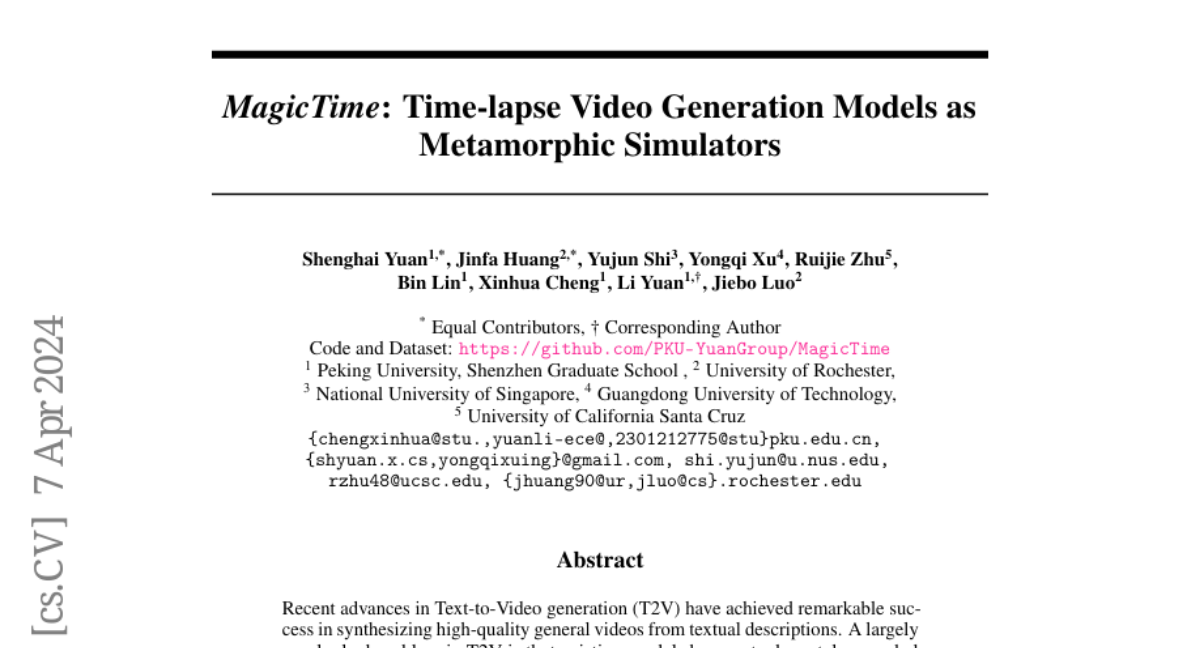
Recent advances in Text-to-Video generation (T2V) have achieved remarkable success in synthesizing high-quality general videos from textual descriptions. A largely overlooked problem in T2V is that existing models have not adequately encoded physical knowledge of the real world, thus generated videos tend to have limited motion and poor variations. In this paper, we propose \textbf{MagicTime}, a metamorphic time-lapse video generation model, which learns real-world physics knowledge from time-lapse videos and implements metamorphic generation. First, we design a MagicAdapter scheme to decouple spatial and temporal training, encode more physical knowledge from metamorphic videos, and transform pre-trained T2V models to generate metamorphic videos. Second, we introduce a Dynamic Frames Extraction strategy to adapt to metamorphic time-lapse videos, which have a wider variation range and cover dramatic object metamorphic processes, thus embodying more physical knowledge than general videos. Finally, we introduce a Magic Text-Encoder to improve the understanding of metamorphic video prompts. Furthermore, we create a time-lapse video-text dataset called \textbf{ChronoMagic}, specifically curated to unlock the metamorphic video generation ability. Extensive experiments demonstrate the superiority and effectiveness of MagicTime for generating high-quality and dynamic metamorphic videos, suggesting time-lapse video generation is a promising path toward building metamorphic simulators of the physical world.
Ferret-UI: Grounded Mobile UI Understanding with Multimodal LLMs
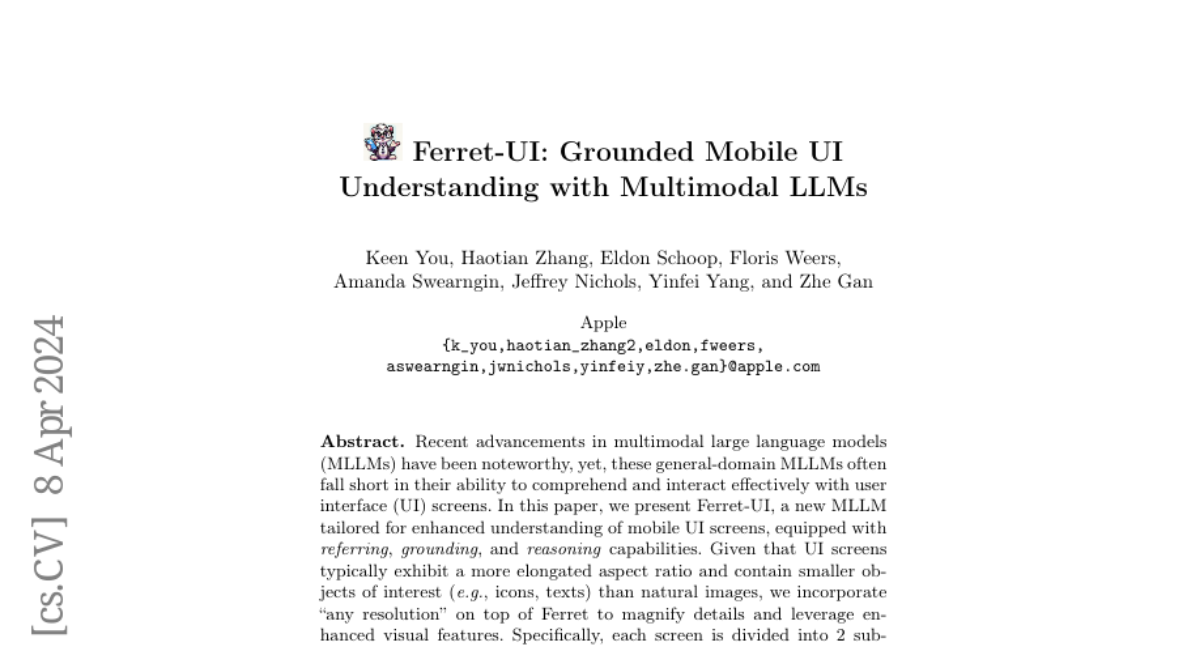
Recent advancements in multimodal large language models (MLLMs) have been noteworthy, yet, these general-domain MLLMs often fall short in their ability to comprehend and interact effectively with user interface (UI) screens. In this paper, we present Ferret-UI, a new MLLM tailored for enhanced understanding of mobile UI screens, equipped with referring, grounding, and reasoning capabilities. Given that UI screens typically exhibit a more elongated aspect ratio and contain smaller objects of interest (e.g., icons, texts) than natural images, we incorporate "any resolution" on top of Ferret to magnify details and leverage enhanced visual features. Specifically, each screen is divided into 2 sub-images based on the original aspect ratio (i.e., horizontal division for portrait screens and vertical division for landscape screens). Both sub-images are encoded separately before being sent to LLMs. We meticulously gather training samples from an extensive range of elementary UI tasks, such as icon recognition, find text, and widget listing. These samples are formatted for instruction-following with region annotations to facilitate precise referring and grounding. To augment the model's reasoning ability, we further compile a dataset for advanced tasks, including detailed description, perception/interaction conversations, and function inference. After training on the curated datasets, Ferret-UI exhibits outstanding comprehension of UI screens and the capability to execute open-ended instructions. For model evaluation, we establish a comprehensive benchmark encompassing all the aforementioned tasks. Ferret-UI excels not only beyond most open-source UI MLLMs, but also surpasses GPT-4V on all the elementary UI tasks.
UniFL: Improve Stable Diffusion via Unified Feedback Learning

Diffusion models have revolutionized the field of image generation, leading to the proliferation of high-quality models and diverse downstream applications. However, despite these significant advancements, the current competitive solutions still suffer from several limitations, including inferior visual quality, a lack of aesthetic appeal, and inefficient inference, without a comprehensive solution in sight. To address these challenges, we present UniFL, a unified framework that leverages feedback learning to enhance diffusion models comprehensively. UniFL stands out as a universal, effective, and generalizable solution applicable to various diffusion models, such as SD1.5 and SDXL. Notably, UniFL incorporates three key components: perceptual feedback learning, which enhances visual quality; decoupled feedback learning, which improves aesthetic appeal; and adversarial feedback learning, which optimizes inference speed. In-depth experiments and extensive user studies validate the superior performance of our proposed method in enhancing both the quality of generated models and their acceleration. For instance, UniFL surpasses ImageReward by 17% user preference in terms of generation quality and outperforms LCM and SDXL Turbo by 57% and 20% in 4-step inference. Moreover, we have verified the efficacy of our approach in downstream tasks, including Lora, ControlNet, and AnimateDiff.
ByteEdit: Boost, Comply and Accelerate Generative Image Editing

Recent advancements in diffusion-based generative image editing have sparked a profound revolution, reshaping the landscape of image outpainting and inpainting tasks. Despite these strides, the field grapples with inherent challenges, including: i) inferior quality; ii) poor consistency; iii) insufficient instrcution adherence; iv) suboptimal generation efficiency. To address these obstacles, we present ByteEdit, an innovative feedback learning framework meticulously designed to Boost, Comply, and Accelerate Generative Image Editing tasks. ByteEdit seamlessly integrates image reward models dedicated to enhancing aesthetics and image-text alignment, while also introducing a dense, pixel-level reward model tailored to foster coherence in the output. Furthermore, we propose a pioneering adversarial and progressive feedback learning strategy to expedite the model's inference speed. Through extensive large-scale user evaluations, we demonstrate that ByteEdit surpasses leading generative image editing products, including Adobe, Canva, and MeiTu, in both generation quality and consistency. ByteEdit-Outpainting exhibits a remarkable enhancement of 388% and 135% in quality and consistency, respectively, when compared to the baseline model. Experiments also verfied that our acceleration models maintains excellent performance results in terms of quality and consistency.
BeyondScene: Higher-Resolution Human-Centric Scene Generation With Pretrained Diffusion
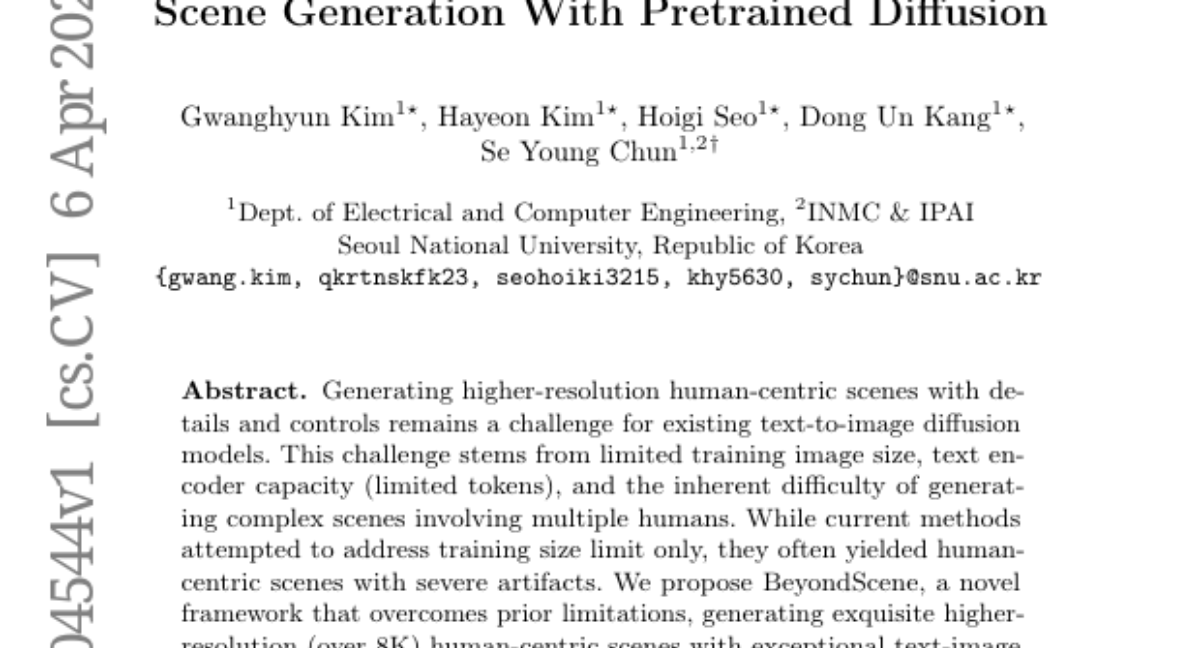
Generating higher-resolution human-centric scenes with details and controls remains a challenge for existing text-to-image diffusion models. This challenge stems from limited training image size, text encoder capacity (limited tokens), and the inherent difficulty of generating complex scenes involving multiple humans. While current methods attempted to address training size limit only, they often yielded human-centric scenes with severe artifacts. We propose BeyondScene, a novel framework that overcomes prior limitations, generating exquisite higher-resolution (over 8K) human-centric scenes with exceptional text-image correspondence and naturalness using existing pretrained diffusion models. BeyondScene employs a staged and hierarchical approach to initially generate a detailed base image focusing on crucial elements in instance creation for multiple humans and detailed descriptions beyond token limit of diffusion model, and then to seamlessly convert the base image to a higher-resolution output, exceeding training image size and incorporating details aware of text and instances via our novel instance-aware hierarchical enlargement process that consists of our proposed high-frequency injected forward diffusion and adaptive joint diffusion. BeyondScene surpasses existing methods in terms of correspondence with detailed text descriptions and naturalness, paving the way for advanced applications in higher-resolution human-centric scene creation beyond the capacity of pretrained diffusion models without costly retraining. Project page: https://janeyeon.github.io/beyond-scene.
Aligning Diffusion Models by Optimizing Human Utility

We present Diffusion-KTO, a novel approach for aligning text-to-image diffusion models by formulating the alignment objective as the maximization of expected human utility. Since this objective applies to each generation independently, Diffusion-KTO does not require collecting costly pairwise preference data nor training a complex reward model. Instead, our objective requires simple per-image binary feedback signals, e.g. likes or dislikes, which are abundantly available. After fine-tuning using Diffusion-KTO, text-to-image diffusion models exhibit superior performance compared to existing techniques, including supervised fine-tuning and Diffusion-DPO, both in terms of human judgment and automatic evaluation metrics such as PickScore and ImageReward. Overall, Diffusion-KTO unlocks the potential of leveraging readily available per-image binary signals and broadens the applicability of aligning text-to-image diffusion models with human preferences.
DATENeRF: Depth-Aware Text-based Editing of NeRFs
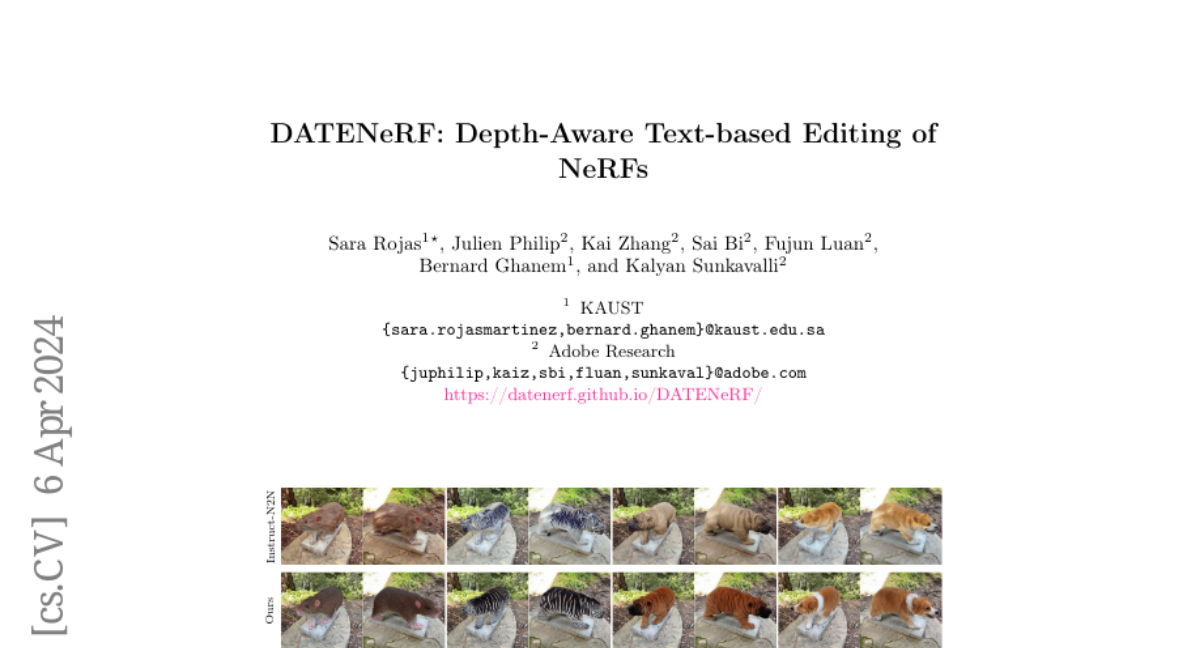
Recent advancements in diffusion models have shown remarkable proficiency in editing 2D images based on text prompts. However, extending these techniques to edit scenes in Neural Radiance Fields (NeRF) is complex, as editing individual 2D frames can result in inconsistencies across multiple views. Our crucial insight is that a NeRF scene's geometry can serve as a bridge to integrate these 2D edits. Utilizing this geometry, we employ a depth-conditioned ControlNet to enhance the coherence of each 2D image modification. Moreover, we introduce an inpainting approach that leverages the depth information of NeRF scenes to distribute 2D edits across different images, ensuring robustness against errors and resampling challenges. Our results reveal that this methodology achieves more consistent, lifelike, and detailed edits than existing leading methods for text-driven NeRF scene editing.
Koala: Key frame-conditioned long video-LLM
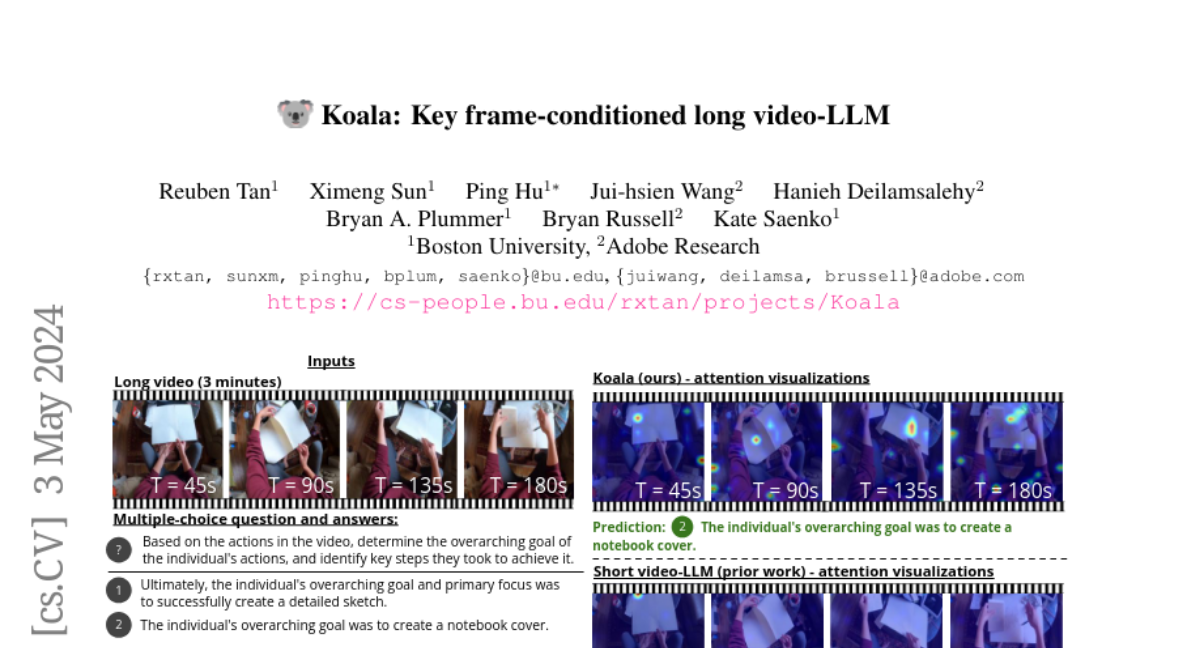
Long video question answering is a challenging task that involves recognizing short-term activities and reasoning about their fine-grained relationships. State-of-the-art video Large Language Models (vLLMs) hold promise as a viable solution due to their demonstrated emergent capabilities on new tasks. However, despite being trained on millions of short seconds-long videos, vLLMs are unable to understand minutes-long videos and accurately answer questions about them. To address this limitation, we propose a lightweight and self-supervised approach, Key frame-conditioned long video-LLM (Koala), that introduces learnable spatiotemporal queries to adapt pretrained vLLMs for generalizing to longer videos. Our approach introduces two new tokenizers that condition on visual tokens computed from sparse video key frames for understanding short and long video moments. We train our proposed approach on HowTo100M and demonstrate its effectiveness on zero-shot long video understanding benchmarks, where it outperforms state-of-the-art large models by 3 - 6% in absolute accuracy across all tasks. Surprisingly, we also empirically show that our approach not only helps a pretrained vLLM to understand long videos but also improves its accuracy on short-term action recognition.
MA-LMM: Memory-Augmented Large Multimodal Model for Long-Term Video Understanding

With the success of large language models (LLMs), integrating the vision model into LLMs to build vision-language foundation models has gained much more interest recently. However, existing LLM-based large multimodal models (e.g., Video-LLaMA, VideoChat) can only take in a limited number of frames for short video understanding. In this study, we mainly focus on designing an efficient and effective model for long-term video understanding. Instead of trying to process more frames simultaneously like most existing work, we propose to process videos in an online manner and store past video information in a memory bank. This allows our model to reference historical video content for long-term analysis without exceeding LLMs' context length constraints or GPU memory limits. Our memory bank can be seamlessly integrated into current multimodal LLMs in an off-the-shelf manner. We conduct extensive experiments on various video understanding tasks, such as long-video understanding, video question answering, and video captioning, and our model can achieve state-of-the-art performances across multiple datasets. Code available at https://boheumd.github.io/MA-LMM/.
YaART: Yet Another ART Rendering Technology
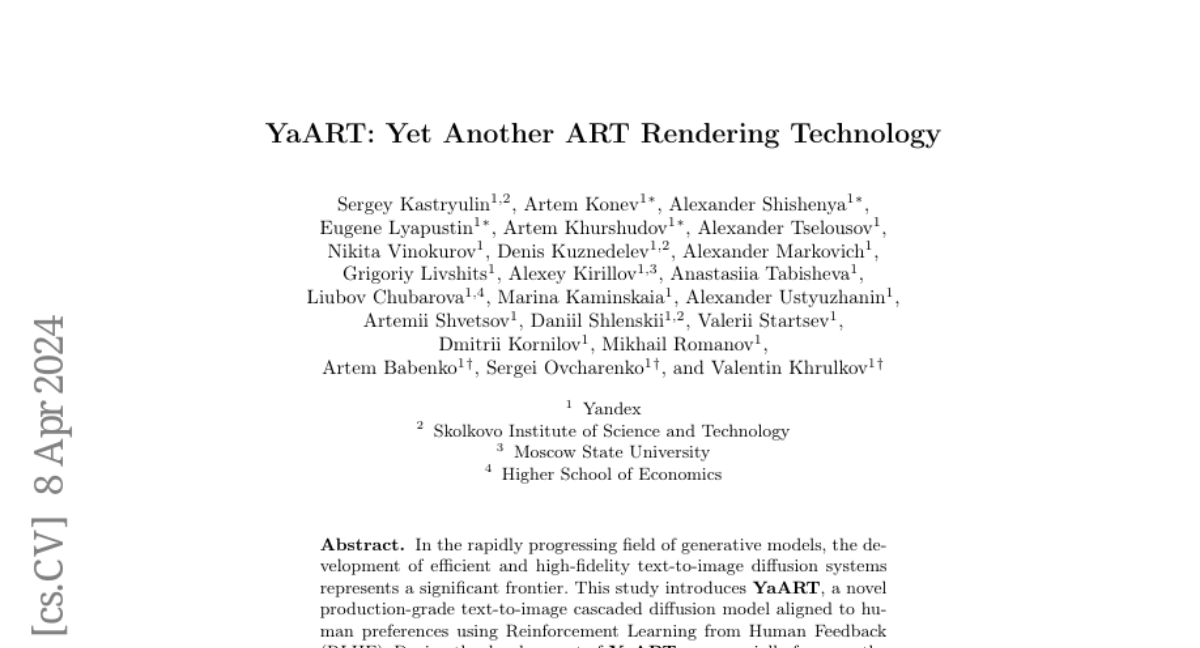
In the rapidly progressing field of generative models, the development of efficient and high-fidelity text-to-image diffusion systems represents a significant frontier. This study introduces YaART, a novel production-grade text-to-image cascaded diffusion model aligned to human preferences using Reinforcement Learning from Human Feedback (RLHF). During the development of YaART, we especially focus on the choices of the model and training dataset sizes, the aspects that were not systematically investigated for text-to-image cascaded diffusion models before. In particular, we comprehensively analyze how these choices affect both the efficiency of the training process and the quality of the generated images, which are highly important in practice. Furthermore, we demonstrate that models trained on smaller datasets of higher-quality images can successfully compete with those trained on larger datasets, establishing a more efficient scenario of diffusion models training. From the quality perspective, YaART is consistently preferred by users over many existing state-of-the-art models.
SwapAnything: Enabling Arbitrary Object Swapping in Personalized Visual Editing

Effective editing of personal content holds a pivotal role in enabling individuals to express their creativity, weaving captivating narratives within their visual stories, and elevate the overall quality and impact of their visual content. Therefore, in this work, we introduce SwapAnything, a novel framework that can swap any objects in an image with personalized concepts given by the reference, while keeping the context unchanged. Compared with existing methods for personalized subject swapping, SwapAnything has three unique advantages: (1) precise control of arbitrary objects and parts rather than the main subject, (2) more faithful preservation of context pixels, (3) better adaptation of the personalized concept to the image. First, we propose targeted variable swapping to apply region control over latent feature maps and swap masked variables for faithful context preservation and initial semantic concept swapping. Then, we introduce appearance adaptation, to seamlessly adapt the semantic concept into the original image in terms of target location, shape, style, and content during the image generation process. Extensive results on both human and automatic evaluation demonstrate significant improvements of our approach over baseline methods on personalized swapping. Furthermore, SwapAnything shows its precise and faithful swapping abilities across single object, multiple objects, partial object, and cross-domain swapping tasks. SwapAnything also achieves great performance on text-based swapping and tasks beyond swapping such as object insertion.
Diffusion-RWKV: Scaling RWKV-Like Architectures for Diffusion Models

Transformers have catalyzed advancements in computer vision and natural language processing (NLP) fields. However, substantial computational complexity poses limitations for their application in long-context tasks, such as high-resolution image generation. This paper introduces a series of architectures adapted from the RWKV model used in the NLP, with requisite modifications tailored for diffusion model applied to image generation tasks, referred to as Diffusion-RWKV. Similar to the diffusion with Transformers, our model is designed to efficiently handle patchnified inputs in a sequence with extra conditions, while also scaling up effectively, accommodating both large-scale parameters and extensive datasets. Its distinctive advantage manifests in its reduced spatial aggregation complexity, rendering it exceptionally adept at processing high-resolution images, thereby eliminating the necessity for windowing or group cached operations. Experimental results on both condition and unconditional image generation tasks demonstrate that Diffison-RWKV achieves performance on par with or surpasses existing CNN or Transformer-based diffusion models in FID and IS metrics while significantly reducing total computation FLOP usage.
PhysAvatar: Learning the Physics of Dressed 3D Avatars from Visual Observations

Modeling and rendering photorealistic avatars is of crucial importance in many applications. Existing methods that build a 3D avatar from visual observations, however, struggle to reconstruct clothed humans. We introduce PhysAvatar, a novel framework that combines inverse rendering with inverse physics to automatically estimate the shape and appearance of a human from multi-view video data along with the physical parameters of the fabric of their clothes. For this purpose, we adopt a mesh-aligned 4D Gaussian technique for spatio-temporal mesh tracking as well as a physically based inverse renderer to estimate the intrinsic material properties. PhysAvatar integrates a physics simulator to estimate the physical parameters of the garments using gradient-based optimization in a principled manner. These novel capabilities enable PhysAvatar to create high-quality novel-view renderings of avatars dressed in loose-fitting clothes under motions and lighting conditions not seen in the training data. This marks a significant advancement towards modeling photorealistic digital humans using physically based inverse rendering with physics in the loop. Our project website is at: https://qingqing-zhao.github.io/PhysAvatar
MoMA: Multimodal LLM Adapter for Fast Personalized Image Generation
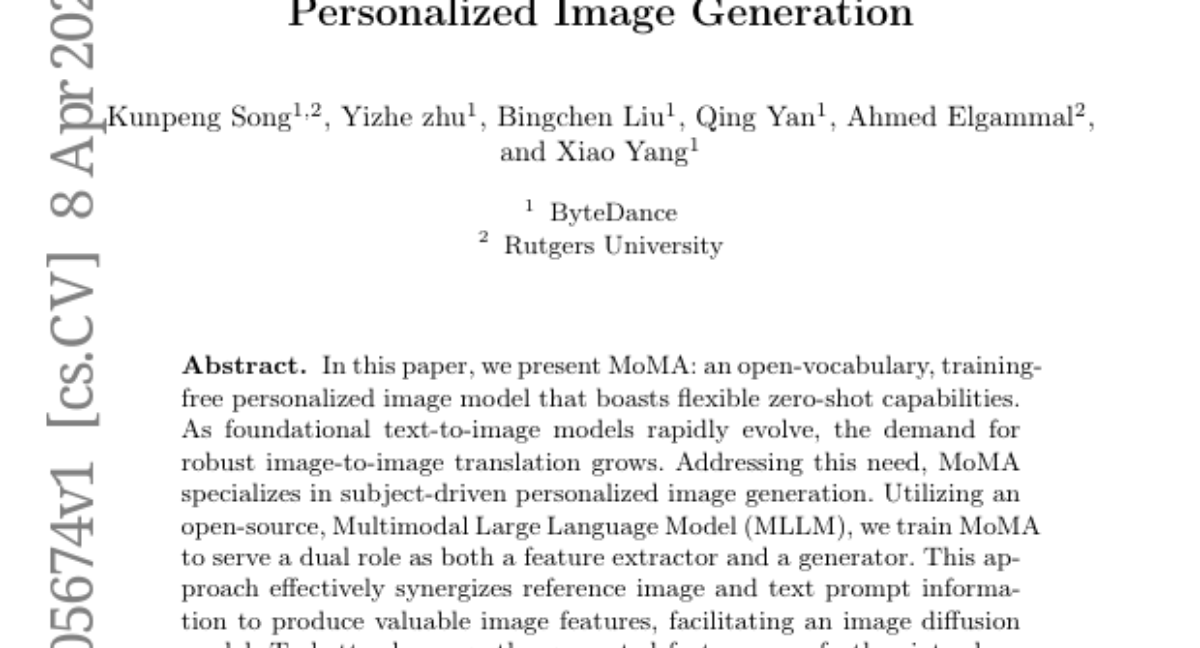
In this paper, we present MoMA: an open-vocabulary, training-free personalized image model that boasts flexible zero-shot capabilities. As foundational text-to-image models rapidly evolve, the demand for robust image-to-image translation grows. Addressing this need, MoMA specializes in subject-driven personalized image generation. Utilizing an open-source, Multimodal Large Language Model (MLLM), we train MoMA to serve a dual role as both a feature extractor and a generator. This approach effectively synergizes reference image and text prompt information to produce valuable image features, facilitating an image diffusion model. To better leverage the generated features, we further introduce a novel self-attention shortcut method that efficiently transfers image features to an image diffusion model, improving the resemblance of the target object in generated images. Remarkably, as a tuning-free plug-and-play module, our model requires only a single reference image and outperforms existing methods in generating images with high detail fidelity, enhanced identity-preservation and prompt faithfulness. Our work is open-source, thereby providing universal access to these advancements.
SpatialTracker: Tracking Any 2D Pixels in 3D Space
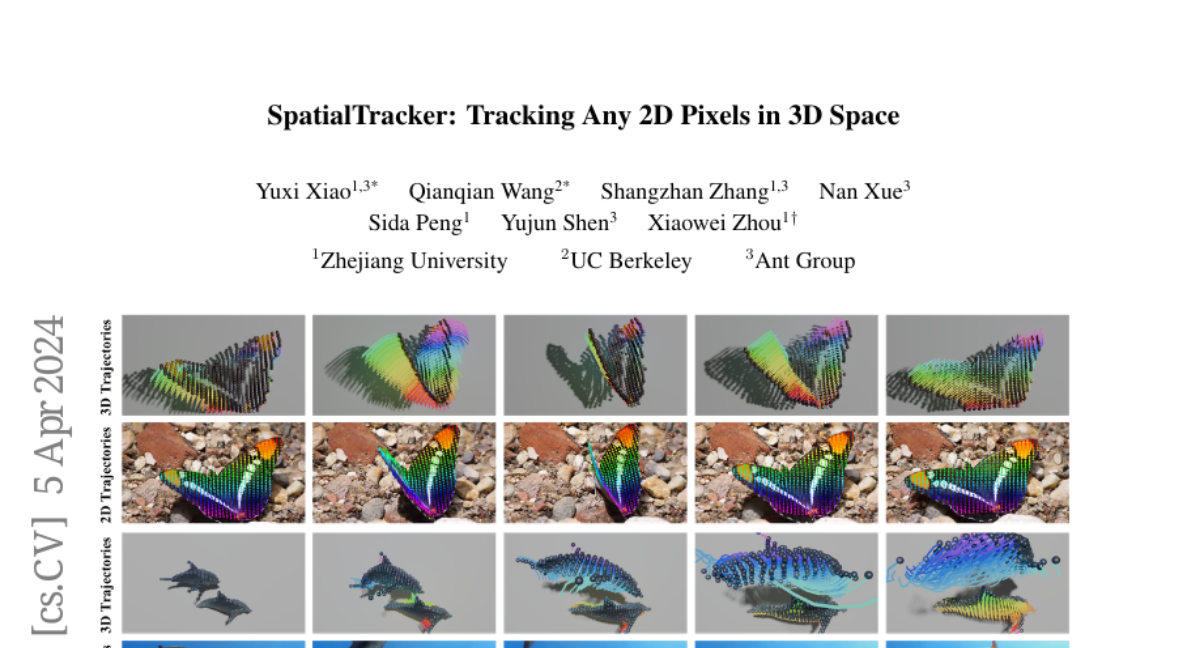
Recovering dense and long-range pixel motion in videos is a challenging problem. Part of the difficulty arises from the 3D-to-2D projection process, leading to occlusions and discontinuities in the 2D motion domain. While 2D motion can be intricate, we posit that the underlying 3D motion can often be simple and low-dimensional. In this work, we propose to estimate point trajectories in 3D space to mitigate the issues caused by image projection. Our method, named SpatialTracker, lifts 2D pixels to 3D using monocular depth estimators, represents the 3D content of each frame efficiently using a triplane representation, and performs iterative updates using a transformer to estimate 3D trajectories. Tracking in 3D allows us to leverage as-rigid-as-possible (ARAP) constraints while simultaneously learning a rigidity embedding that clusters pixels into different rigid parts. Extensive evaluation shows that our approach achieves state-of-the-art tracking performance both qualitatively and quantitatively, particularly in challenging scenarios such as out-of-plane rotation.